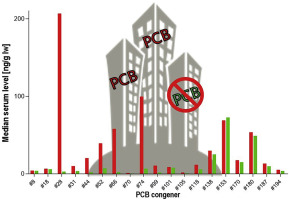International Journal of Hygiene and Environmental Health ( IF 6 ) Pub Date : 2019-12-24 , DOI: 10.1016/j.ijheh.2019.113430 Marie Frederiksen 1 , Helle Vibeke Andersen 2 , Line Småstuen Haug 3 , Cathrine Thomsen 3 , Sharon Lynn Broadwell 3 , Emilie Lund Egsmose 4 , Barbara Kolarik 2 , Lars Gunnarsen 2 , Lisbeth E Knudsen 4

|
Exposure to polychlorinated biphenyls (PCB) in buildings constructed with PCB-containing materials can lead to increased body burden of PCB for building users. Exposure to PCB from building related sources was assessed by measuring PCB in serum and hand wipes in two groups of tenants living in the same building estate in apartments constructed with and without PCB. The median serum levels of the sum of 19 PCB congeners was 777 ng/g lw (5–95th percentile: 219–2576 ng/g lw) for the exposed group and 282 ng/g lw (5–95th percentile: 49.8–797 ng/g lw) for the reference group. The congener pattern in serum of the exposed was shifted towards lower chlorinated congeners and was dominated by tri- and tetrachlorinated congeners. The largest difference in serum levels between the groups was observed for PCB-28, with median levels of the exposed being 70 times higher than in the reference group. For very persistent lower chlorinated congeners, like PCB-28, 66 and 74, an increase with residence times was observed as a result of accumulation over time. Less persistent congeners such as PCB-44 and 70 were also elevated in the exposed group -but independent of residence time. The less persistent congeners can therefore be used as markers of recent exposure to original PCB sources. The hand wipes also showed a large exposure contrast, e.g. PCB-28 being more than 60 times higher in the exposed group compared to the reference group (medians 14.4 and 0.23 ng/wipe, respectively) and no overlap between the groups. All measured di- to pentaPCB congeners were significantly higher in hand wipes from the exposed group compared with the reference group. Thus hand wipes seem to be a good, non-invasive screening tool for ongoing indoor exposure to PCB. Furthermore, the measured level of PCB on hand wipes was significantly correlated to PCB in blood for almost all congeners. In conclusion, PCB exposure in contaminated buildings can contribute significantly to the exposure and total body burden of PCB and the lower chlorinated congeners can make up the majority of the total PCB body burden.
中文翻译:

居住在受污染的高层公寓大楼中的裸露居民和参考人群中血清和手湿巾中的PCB。
在使用含有多氯联苯的材料建造的建筑物中暴露于多氯联苯(PCB)会导致建筑使用者增加PCB的身体负担。通过测量居住在使用和不使用PCB的公寓中同一建筑群中的两组租户的血清和擦手液中的PCB,来评估与建筑物相关的源对PCB的暴露程度。暴露组的19种多氯联苯的总和的中值血清水平为777 ng / g lw(5-95%:219–2576 ng / g lw)和282 ng / g lw(5-95%:49.8–797) ng / g lw)作为参考组。暴露者血清中的同类物模式向低氯同类物转移,并以三氯和四氯同类物为主。对于PCB-28,两组之间的血清水平差异最大,暴露的中位数水平是参考组的70倍。对于非常持久的低氯同类物,如PCB-28、66和74,随着时间的积累,观察到了停留时间的增加。在接触组中,持久性较弱的同类物(如PCB-44和70)也升高了-但与停留时间无关。因此,持久性较低的同类物可以用作最近暴露于原始PCB来源的标记。擦手纸还显示出很大的曝光对比度,例如,与参考组相比,曝光组的PCB-28含量高60倍以上(分别为中值14.4和0.23 ng /擦),并且各组之间没有重叠。与参考组相比,暴露组的手擦拭纸中所有测得的dito至pentaPCB同类物均显着更高。因此,擦拭手巾似乎是持续暴露于室内的PCB的良好非侵入性筛查工具。此外,几乎所有同类产品的手擦板上的PCB含量与血液中的PCB均显着相关。总而言之,在受污染的建筑物中,PCB暴露量可极大地影响PCB的暴露量和人体总负荷,而氯含量较低的同类物质可占PCB人体总负荷的大部分。



























 京公网安备 11010802027423号
京公网安备 11010802027423号